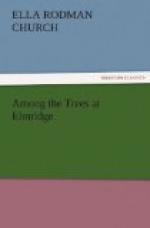“Yes; you are really learning to distinguish trees very well. There are several species—the white, red, black and mountain ash. The white ash is a graceful tree, rising in the forest to the height of seventy or eighty feet, with a straight trunk and a diameter of three feet or more at the base. On an open plain it throws out its branches, with a gentle double curvature, to a distance on every side, and forms a broad, round head of great beauty. The flowers of the ash are greenish white in color and appear with the leaves in loose clusters. ’The trunk of our largest American ash is covered with a whitish bark which in very young trees is nearly smooth; on older trees it is broken by deep furrows into irregular plates, and on very old stems it becomes smooth again, from the rough plates scaling off. The branches are grayish green dotted with gray or white.’ Now who can tell me something about this tree?”
“I know that furniture is made of the wood,” said Clara, “because that pretty set in the large spare-room is ash. And it is very light-colored.”
“The wood is used for a great many things,” replied Miss Harson, “and the ash has been called the husbandman’s tree because the timber is so much in demand for farming-implements, and for articles that need to be both strong and light. It does not last so long as the oak, but it is more elastic and can better resist sudden shocks and jerks; it is therefore particularly desirable for the spokes of wheels and ladders and the beams of floors. Staircases were made of it in olden times, and they may still be found in some English halls and abbeys. The forest ash makes better oars than any other wood, and the tree has so many good qualities that an old English poet spoke of it as
“‘The ash for nothing ill.’
“But Malcolm looks as if he had something to say, and I shall be very happy to hear it.”
“It is only about the red berries that they bear in autumn, Miss Harson; it looks queer to see berries growing on a tree.”
“The mountain ash is the only one that has berries,” replied his governess, “and the bloom is in clusters of white flowers. The berries are sometimes dark red and often of a bright scarlet, and they remain on the tree during the winter, to the great delight of the birds. We should find them very sour, although pretty to look at; but the little feathered wanderers eat them with great relish when the snows of winter make bird-food scarce and the bright-red berries gleam out most invitingly. In some parts of Europe the berries are dried and ground into flour. The rowan, or roan, tree is the English name of the mountain ash, and in some parts of Great Britain it is called witchen, because of its supposed power against witches and evil spirits and all their spells. In old times branches of it were hung about houses and stables and cow-sheds, for it was thought that
“’witches
have no power
Where there is roan-tree
wood.’”




